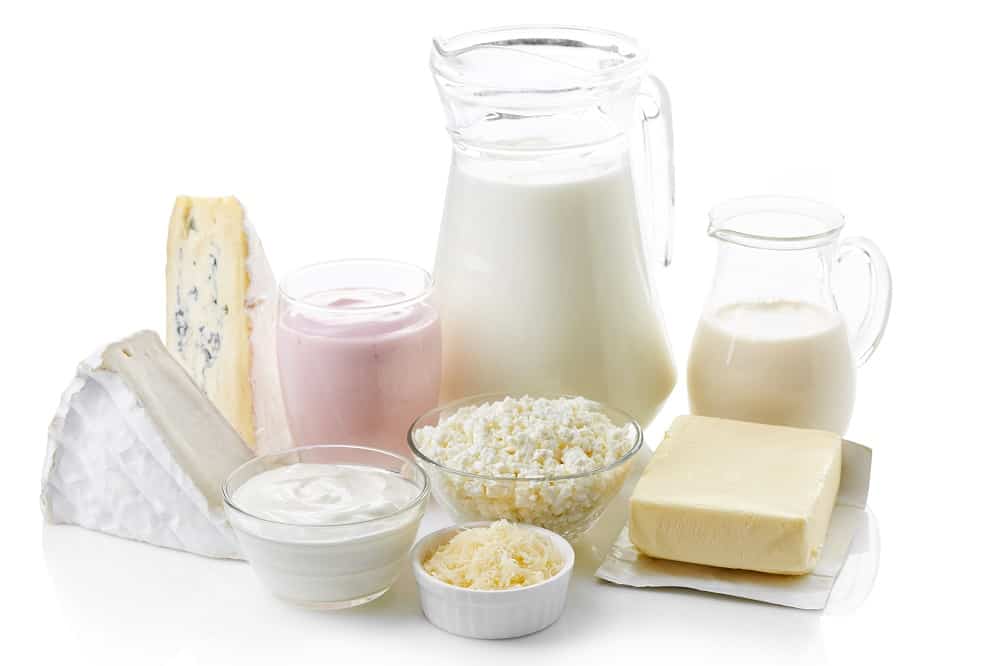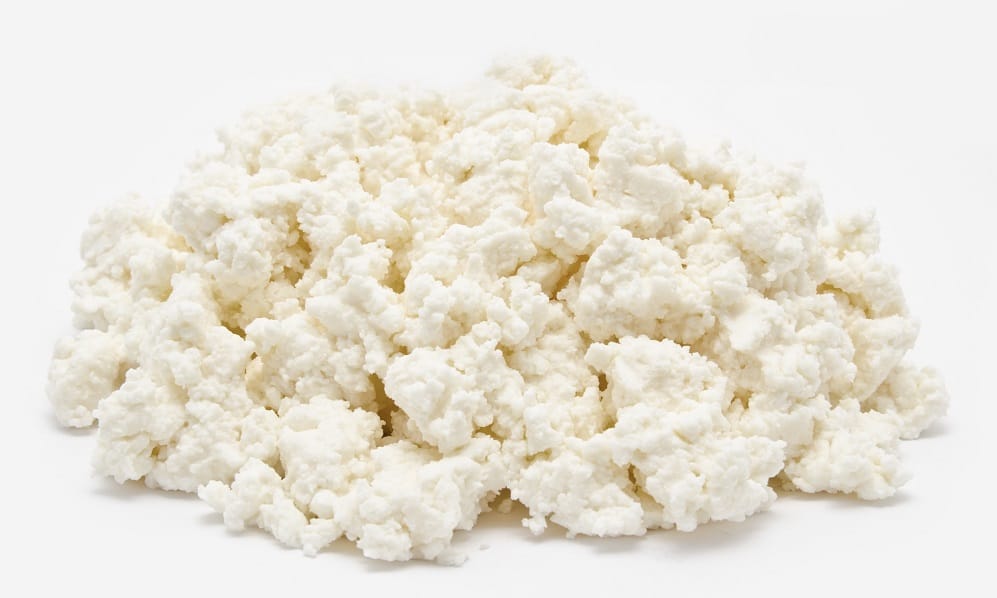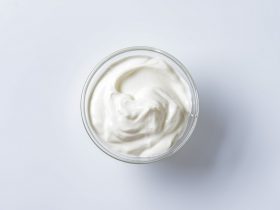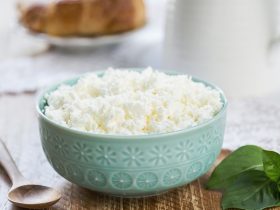Evidences support the addition of dairy foods as part of a balanced diet (Marangoni et al., 2019). During pregnancy, it is increasingly being acknowledged that maternal diet influences the development of the fetus and health of the child later in life (Brantsæter et al., 2012).
In general, cottage cheese is considered safe for consumption during pregnancy. However, caution is still advised.
Benefits of Consumption of Dairy Foods

Milk is a major source of calcium in the diet. Milk proteins are of high biological value because of their high digestibility and bioavailability (Marangoni et al., 2019). The bioavailability of calcium has been shown to be higher in dairy foods compared to other food sources (Timon et al., 2020).
Dairy foods are natural sources of proteins, fats, oligosaccharides and micronutrients, including vitamins A, D, E and K, and calcium, magnesium, phosphorus and zinc (Haug et al., 2007). The 2015-2020 Dietary Guidelines for Americans (DGA) recommends the consumption of 3 cup equivalents (c-eq) of dairy foods daily (Scrafford et al., 2020). According to Fulgoni et al. in 2011, less than half of the dietary calcium requirements would be met if dairy products are not consumed.
Research shows that consumption of recommended amounts of dairy products was associated with decreased risk for chronic health illnesses, such as obesity, cardiovascular disease, type 2 diabetes mellitus, and metabolic syndrome (Scrafford et al., 2020).
According to Chartier et al. in 2016, there was moderate to high quality of evidence supporting the association of consumption of total dairy, cheese and yogurt with favorable or neutral outcomes of stroke, coronary heart disease, hypertension, and type 2 diabetes mellitus. Likewise, Marangoni et al. in 2019 found preliminary evidence suggesting potentially protective effects of milk consumption against overweight, obesity, diabetes and cardiovascular disease.
During pregnancy, dairy foods can be a means of providing enough calcium and other key nutrients for proper fetal development. Previous studies suggest that moderate milk consumption during pregnancy was positively associated with fetal growth and infant birth weight when compared to no or low intake (Brantsæter et al., 2012). Because dairy foods are rich in high quality proteins, calcium and vitamin D, maternal intake may also influence later bone health status (Perreault et al., 2018).
Moreover, dairy contains leucine, which inhibits adipogenesis (formation of fat cells) and enhances lipolysis (breaking down of fats), thereby possibly contributing to healthy gestational weight gain. In addition, consumption of dairy proteins may also improve dysglycemia, high blood pressure, blood lipid profiles, and risk of preeclampsia in pregnant women (Perreault et al., 2018).
What is Cottage Cheese?

Cottage cheese is low in calories but high in protein and essential nutrients. It is considered a fresh cheese and does not undergo ripening or aging to develop its flavor. Therefore, it has a mild flavor compared with aged cheeses.
Cottage cheese is made from curds of pasteurized cow’s milk, including non-fat, reduced fat or regular milk. It is also produced in different curd sizes, including small, medium or large.
The first step to making cottage cheese is to curdle the milk. An acidic substance, like lime juice or vinegar, or an acid-producing culture is added to milk. With increased acidity, the milk solids (curds) separate from the liquid whey protein of the milk.
When the curds have solidified, they are cut into pieces and cooked so that more moisture is released. Then, the curds are washed to remove the acidity and drained to further remove moisture. Lastly, ingredients (cream, salt, herbs and spices) can be added to increase its flavor.
The curds give cottage cheese a lumpy appearance. However, some brands are smooth or whipped, hence, there are no lumps. Flavored cottage cheese can contain added sugars or salts, and is higher in calories than plain varieties. Therefore, pregnant women should always check the label.
Is Cottage Cheese Safe for Pregnant Women to Eat?
In 2018, Perreault et al. made a randomized controlled trial to study the effect of nutrition during pregnancy. In this study, participants were provided with low-fat milk, cottage cheese, and/or yogurt to ensure that they consume enough amounts of dairy.
According to the National Health Service (NHS) website, pregnant women can eat all hard cheeses, soft pasteurized cheeses, including cottage cheese, and all other cheeses that have been thoroughly cooked. In contrast, pregnant women are advised to avoid mold-ripened soft cheeses – like blue cheese – and any cheese that is made from unpasteurized milk because of the risk of an infection called Listeriosis.
Soft cheeses made with pasteurized milk are generally considered safe. These include commercial cottage cheese, cream cheese, and processed mozzarella. However, consumers cannot rely on labels alone to evaluate the conditions under which a cheese was made. Therefore, people at higher risk for infection with L. monocytogenes, including pregnant women, are advised to carefully consider cheeses before consumption (Jackson et al., 2018).
This is in accordance to the recommendations from the New South Wales Food Authority website, which states that cottage cheese, along with processed cheese, cheese spreads and cream cheese, can be eaten with caution. They should be stored in the refrigerator and eaten within two days of opening the package.
Risk of Contamination with Listeria Monocytogenes
According to Scallan et al. (2011), there are 9.4 million episodes of food borne diseases every year. Leading causes of death were infections from Salmonella (28%), Toxoplasma (24%), Listeria (19%) and Norovirus (11%).
Listeria monocytogenes is a widely dispersed natural bacterium that can develop at refrigeration temperatures. Listeriosis can cause serious sickness and death. People at higher danger for infection include older adults, immunocompromised individuals, and pregnant women and their babies (Jackson et al., 2018).
99% of Listeriosis cases in humans are contracted through consumption of contaminated food (Scallan et al., 2011). Outbreaks of Listeriosis have been associated with several types of ready to eat (RTE) foods, including unpasteurized dairy products like Mexican soft cheese, raw milk cheese, and farm fresh cheese. Even pasteurized dairy products, such as butter, soft cheese, sour milk curd cheese, and fluid milk have been linked to certain infections (McIntyre et al., 2015).
Soft ripened cheese is more vulnerable to bacterial contamination after pasteurization because of its low acidity and high moisture content (McIntyre et al., 2015), which also favor the growth of L. monocytogenes. The U.S. Food and Drug Administration (FDA) and Health Canada estimate that the risk of infection with unpasteurized soft cheeses is 50 to 160 times greater per serving when compared to those made with pasteurized milk (Heiman et al., 2016).
Based on a US retail survey from 2000 to 2001, L. monocytogenes was detected in 1.3% of soft cheeses, including Latin-style, blue-veined, and mold-ripened cheese, made from unpasteurized sources, and 0.5% of those made with pasteurized milk (Jackson et al., 2018).
L. monocytogenes causes bacteremia, meningitis and complications during pregnancy (Heiman et al., 2016). Estimated risk of Listeriosis was highest for pregnant women. Soft and semi-soft cheeses were one of the food types associated with large numbers of cases per year (Ricci et al., 2018).
In pregnant women, Listeriosis is commonly a nonspecific febrile illness. However, it can result in fetal demise, preterm birth, and sepsis and meningitis in the newborn (Heiman et al., 2016), as well as infant encephalitis and spontaneous abortions during the last trimester of pregnancy (McIntyre et al., 2015).
In 1985, the first case of Listeriosis was reported in the United States. The case was associated with Latin-style cheese (queso fresco and cotija), and caused 142 illnesses, 28 deaths, and 20 fetal losses. Despite the label saying the cheese was made from pasteurized milk, apparently raw milk was unintentionally mixed with the pasteurized milk (Jackson et al., 2018).
L. monocytogenes is killed by pasteurization. However, even pasteurized milk and dairy products can become contaminated with Listeria because of poor hygiene practices after pasteurization. Eating contaminated soft cheeses prepared under poor sanitary conditions continues to cause Listeriosis outbreaks in the United States (Jackson et al., 2018).
Listeriosis outbreaks from 1998 to 2014 documented 180 illnesses, 14 fetal losses, and 17 deaths. 30% of the cases were associated with consumption of soft cheese. Meanwhile, 44% were reported in pregnant women (Jackson et al., 2018).
Still according to Jackson et al. (2018), the number of Listeriosis outbreaks in the US has been increasing since 2006. These outbreaks were associated with cheese made under unsanitary conditions; Two-thirds of cases were linked to Latin style soft cheese and affected pregnant Hispanic women and their infants.
Moreover, it was demonstrated that food borne pathogens can be transferred from dairy animals to the dairy processing plant (Danielsson-Tham et al., 2004).
Increased incidence of contamination with L. monocytogenes has been associated with dairy farms with poor hygienic practices. Contamination may be introduced through poor employee hygiene, poor plant design, equipment malfunction, from other nondairy ingredients like spices, starter cultures and water, and poor sanitation and pest control (Fox et al., 2009).
Final Thoughts
Cottage cheese is considered generally safe to consume during pregnancy. However, caution is still warranted as even dairy products made from pasteurized milk has been found to be contaminated with Listeria monocytogenes and can cause Listeriosis infection. Checking the label may not be enough, as poor employee sanitation and plant designs are other ways of bacterial contamination.
Dairy foods are good and even essential in the diet of pregnant women. However, the best advice is still for pregnant women to check with their primary physician or obstetrician regarding their dietary choices.
References
- https://www.healthline.com/
- https://www.consumerreports.org/
- https://www.nhs.uk/
- https://www.foodauthority.nsw.gov.au/
- Brantsæter, A. L., Olafsdottir, A., Forsum, E., Olsen, S., & Thorsdottir, I. (2012). Does milk and dairy consumption during pregnancy influence fetal growth and infant birthweight: A systematic literature review. Food & Nutrition Research, 56. doi: 10.3402/fnr.v56i0.20050
- Chartier, J., Brassard, D., Grenier, M., Cote, J. A., Labonte, M., Desroches, S., …, Lamarche, B. (2016). Systematic review of the association between dairy product consumption and risk of cardiovascular-related clinical outcomes. Advances in Nutrition 7(6), 1026-1040. doi: 10.3945/an.115.011403
- Danielsson-Tham, M. L., Eriksson, E., Helmersson, S., Leffler, M., Ludtke, L., Steen, M., …, & Tham, W. (2004). Causes behind a human cheese-borne outbreak of gastrointestinal listeriosis. Foodborne Pathogens and Disease 1(3), 153-159. doi: 10.1089/fpd.2004.1.153
- Fox, E., O’Mahony, T., Clancy, M., Dempsey, R., O’Brien, M., & Jordan, K. (2009). Listeria monocytogenes in the Irish dairy farm environment. Journal of Food Protection 72(7), 1450-1456. doi: 10.4315/0362-028x-72.7.1450
- Fulgoni, V., 3rd, Keast, D., Auestad, N., & Quann, E. (2011). Nutrients from dairy foods are difficult to replace in diets of Americans: Food pattern modeling and an analyses of the National Health and Nutrition Examination Survey 2003-2006. Nutrition Research 31(10), 759-765. doi: 10.1016/j.nutres.2011.09.017
- Haug, A., Hostmark, A., & Harstad, O. (2007). Bovine milk in human nutrition: A review. Lipids in Health and Disease 6, 25. doi: 10.1186/1476-511X-6-25
- Heiman, K. E., Garalde, V. B., Gronostaj, M., Jackson, K. A., Beam, S., Joseph, L., …, & Silk, B. J. (2016). Multistate outbreak of listeriosis caused by imported cheese and evidence of cross-contamination of other cheeses, USA, 2012. Epidemiology & Infection 144(13), 2698-2708. doi: 10.1017/S095026881500117X
- Jackson, K., Gould, L. H., Hunter, J., Kucerova, Z., & Jackson, B. (2018). Listeriosis outbreaks associated with soft cheeses, United States, 1998-2014. Emerging Infectious Diseases 24(6), 1116-1118. doi: 10.3201/eid2406.171051
- Marangoni, F., Pellegrino, L., Verduci, E., Ghiselli, A., Bernabei, R., Calvani, R., …, & Poli, A. (2019). Cow’s milk consumption and health: A health professional’s guide. Journal of the American College of Nutrition 38(3), 197-208. doi: 10.1080/07315724.2018.1491016
- McIntyre, L., Wilcott, L., & Naus, M. (2015). Listeriosis outbreaks in British Columbia, Canada, caused by soft ripened cheese contaminated from environmental sources. BioMed Research International 2015, 131623. doi: 10.1155/2015/131623
- Perreault, M., Atkinson, S., Mottola, M., Phillips, S., Bracken, K., Hutton, E., …, & Prapavessis, H. (2018). Structured diet and exercise guidance in pregnancy to improve health in women and their offspring: Study protocol for the Be Healthy in Pregnancy (BHIP) randomized controlled trial. Trials 19, 691. doi: 10.1186/s13063-018-3065-x
- Ricci, A., Allende, A., Bolton, D., Chemaly, M., Davies, R., Escamez, P. S., …, & Lindqvist, R. (2018). Listeria monocytogenes contamination of ready-to-eat foods and the risk for human health in the EU. EFSA Journal 16(1), e05134. doi: 10.2903/j.efsa.2018.5134
- Scallan, E., Hoekstra, R., Angulo, F., Tauxe, R., Widdowson, M., Roy, S., …, & Griffin, P. (2011). Foodborne illness acquired in the United States: Major pathogens. Emerging Infectious Diseases 17(1), 7-15. doi: 10.3201/eid1701.p11101
- Scrafford, C., Bi, X., Multani, J., Murphy, M., Schmier, J., & Barraj, L. (2020). Health care costs and savings associated with increased dairy consumption among adults in the United States. Nutrients 12(1), 233. doi: 10.3390/nu12010233
- Timon, C., O’Connor, A., Bhargava, N., Gibney, E., & Feeney, E. (2020). Dairy consumption and metabolic health. Nutrients 12(10), 3040. doi: 10.3390/nu12103040




